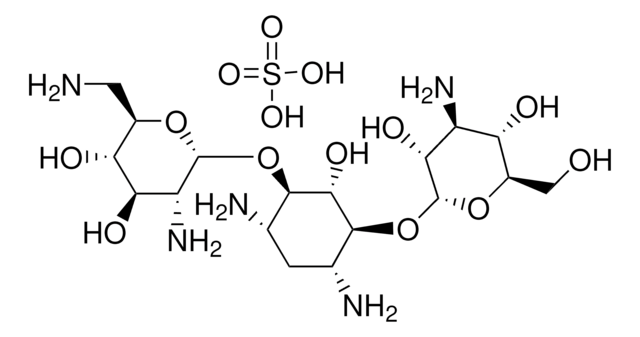Kluczowe dokumenty
B5264
Kanamycin B sulfate salt
aminoglycoside antibiotic
Synonim(y):
Bekanamycin sulfate salt
About This Item
Polecane produkty
Formularz
powder or crystals
spektrum działania antybiotyku
Gram-negative bacteria
Gram-positive bacteria
mycoplasma
Tryb działania
protein synthesis | interferes
temp. przechowywania
−20°C
ciąg SMILES
OS(O)(=O)=O.NC[C@H]1O[C@H](O[C@@H]2[C@@H](N)C[C@@H](N)[C@H](O[C@H]3O[C@H](CO)[C@@H](O)[C@H](N)[C@H]3O)[C@H]2O)[C@H](N)[C@@H](O)[C@@H]1O
InChI
1S/C18H37N5O10.H2O4S/c19-2-6-11(26)12(27)9(23)17(30-6)32-15-4(20)1-5(21)16(14(15)29)33-18-13(28)8(22)10(25)7(3-24)31-18;1-5(2,3)4/h4-18,24-29H,1-3,19-23H2;(H2,1,2,3,4)/t4-,5+,6+,7+,8-,9+,10+,11+,12+,13+,14-,15+,16-,17+,18+;/m0./s1
Klucz InChI
YGTPKDKJVZOVCO-KELBJJLKSA-N
Szukasz podobnych produktów? Odwiedź Przewodnik dotyczący porównywania produktów
Powiązane kategorie
Opis ogólny
Zastosowanie
Działania biochem./fizjol.
Mode of Resistance: Aminoglycoside-modifying enzymes (including acetyltransferase, phosphotransferase, nucleotidyltransferase) can alter this antibiotic, preventing its interaction with ribosomes.
Antimicrobial Spectrum: Kanamycin sulfate is effective against gram-negative and gram-postiive bacteria, and mycoplasma.
Uwaga dotycząca przygotowania
Inne uwagi
Kod klasy składowania
11 - Combustible Solids
Klasa zagrożenia wodnego (WGK)
WGK 2
Temperatura zapłonu (°F)
Not applicable
Temperatura zapłonu (°C)
Not applicable
Środki ochrony indywidualnej
Eyeshields, Gloves, type N95 (US)
Wybierz jedną z najnowszych wersji:
Masz już ten produkt?
Dokumenty związane z niedawno zakupionymi produktami zostały zamieszczone w Bibliotece dokumentów.
Klienci oglądali również te produkty
Nasz zespół naukowców ma doświadczenie we wszystkich obszarach badań, w tym w naukach przyrodniczych, materiałoznawstwie, syntezie chemicznej, chromatografii, analityce i wielu innych dziedzinach.
Skontaktuj się z zespołem ds. pomocy technicznej






